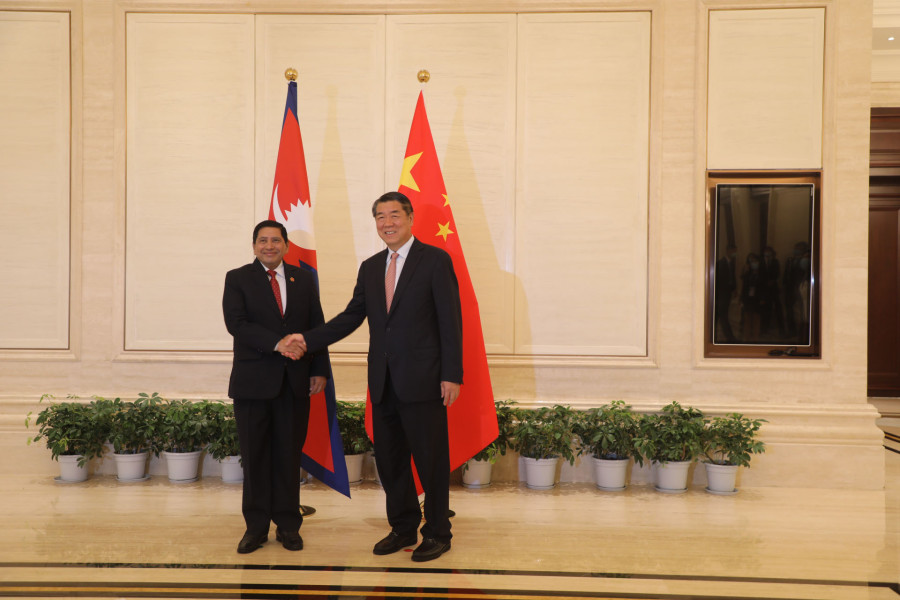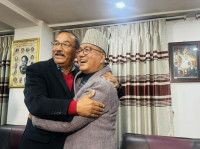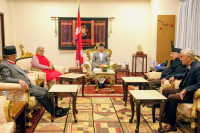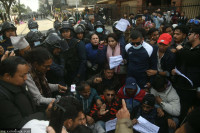Politics
DPM Shrestha urges China to sign implementation deals on BRI projects
Says he asked Chinese leaders to ramp up aid to Nepal in line with the northern neighbour’s economic progress.
Anil Giri
When Chinese leaders asked Nepal to expedite projects under the Belt and Road Initiative (BRI), Deputy Prime Minister Narayan Kaji Shrestha urged them to first sign project implementation agreements.
Shrestha, who visited the Chinese province of Sichuan last week to take part in the 19th Western China Trade Fair, also held talks with Chinese Vice Premier He Lifeng and other senior officials of the Communist Party of China (CPC).
The CPC leaders had expressed their concern over the delay in implementing BRI projects in Nepal, Shrestha told the Post on Monday.
“In reply, I urged them to start the process by signing project implementation agreements. Then we can fix priority projects to be executed under the BRI and funding modalities, among other things,” said Shrestha.
Shrestha, who is also the home minister and had earlier served as foreign minister, also urged the Chinese leaders to fund a landmark BRI project in Nepal through grant assistance.
“After signing project implementation plans, we can discuss funding, which may include grants or soft loans or joint investment,” he added.
Although the Kathmandu-based Chinese Embassy and diplomats insisted that the new Pokhara International Airport is also part of the BRI, Nepali officials have been rejecting the claim saying that the signing of the Pokhara airport was completed some five years ago and BRI figures nowhere in the loan agreement. Nepal officially became part of the BRI in 2017 by signing a framework agreement. The BRI is an ambitious plan launched by Chinese President Xi Jinping to develop two new trade routes connecting China with the rest of the world
Responding to queries from lawmakers in Parliament last week, Foreign Minister NP Saud had said that Nepal and China had signed a framework agreement on the BRI six years ago, and it is still in the stage of execution.
He did not name the Pokhara airport, but stated that not a single project under the BRI has come into operation in Nepal.
“The project implementation plan of the BRI is at the stage of discussion between Nepal and China. Not a single project in Nepal under the BRI has been executed,” said Saud.
After the Nepali side selected nine projects to be executed under the BRI, the second BRI Conference in China in 2019 incorporated the Trans Himalayan Multidimensional Connectivity in its outcome document.
The nine projects were—the Rasuwagadhi-Kathmandu road upgrade; Kimathanka-Hile road construction; road from Dipayal to the Chinese border; Tokha-Bidur road; Galchhi-Rasuwagadhi-Kerung 400kV transmission line; Kerung-Kathmandu rail; 762MW Tamor hydroelectricity project; 426 MW Phukot Karnali hydroelectric project; and the Madan Bhandari Technical Institute.
Then, around two years ago, the Chinese side forwarded a draft of the BRI’s project implementation plan in order to expedite the negotiations and execution of projects. A draft of the implementation plan is a prerequisite for project selection, determining funding, budgeting, supervision and monitoring, and human resource management.
“The Ministry of Foreign Affairs was taking the lead in developing the plan while other agencies like the Office of the Prime Minister and the Ministry of Finance provided inputs on the draft. But there has been no further progress,” according to two officials from foreign and finance ministries.
“Once we agree on the text of the project implementation plan, we can negotiate and execute projects under the BRI,” said the foreign ministry official. “Not only from Nepal, the Chinese had sought similar drafts from other countries that have signed up for the initiative.”
According to the DPM Shrestha, the Chinese side first proposed the project implementation plan and the Nepali side responded with its comments.
“I insisted the Chinese leaders sign the implementation plan,” he said.
The Finance Ministry, while commenting on the text of the project implementation plan, stated that Nepal cannot afford a loan with an annual interest rate of more than one percent, nor can it fund BRI projects through commercial loans. The Nepali side also insisted that there should be a free and fair competition among bidders under the BRI framework.
The major impediment in the selection and implementation of projects is a lack of clarity on the financing modality, according to multiple officials. Nepal, they say, wants grants while China insists on soft loans.
Without progress on a single project, the BRI framework agreement has been renewed twice—most recently in May. Policy coordination, infrastructure connectivity, unimpeded trade, financial integration and connecting people are the five major priority areas of the initiative. The implementation plan encompasses all possible areas of cooperation and gives clarity on project negotiations on both sides.
For example, according to officials working on the draft, if Nepal seeks support for connectivity projects under the BRI, it would make a list of various kinds of projects under air connectivity, physical connectivity, digital connectivity, transmission lines, cultural connectivity and connectivity through trade, goods and commerce.
Another foreign ministry official told the Post that there were some rounds of discussions between the two sides and drafts were exchanged so as to reach a consensus on the proposed projects. But in the absence of a dedicated implementation plan, Nepal could not identify the projects under the BRI.
According to Shrestha, he also urged the Chinese leaders to ramp up Chinese assistance to Nepal in line with China’s economic progress.
“When China was not as rich as it is now, they built several infrastructure projects in Nepal including the Ring Road, Araniko Highway and set up several factories and hydropower stations in Nepal. But now China has become more prosperous, but its economic assistance to Nepal has not increased accordingly. So I urged the Chinese to increase economic assistance and investment in Nepal to match their economic might,” said Shrestha.
Similarly, DPM Shrestha, during his meeting with Chinese leaders, claims to have called for speedy completion of Chinese-involved projects including the second phase of Ring Road expansion, which remains delayed since the Covid pandemic. The detailed project report for the work has not yet been finalized.
Before being appointed home minister, Shrestha served as minister for physical infrastructure and transportation until March. He had also expressed concerns over the delay in the work with the Chinese envoy to Nepal Cheng Song.
In Sichuan, Shrestha had put across the issue of delays in two other projects—the widening works on the Narayanghat-Butwal section of the East-West highway and Abu Khairani-Pokhara section of the Prithvi Highway—both of which are being implemented by Chinese contractors.
Shrestha said he also asked the Chinese leaders to open more trading points between Nepal and China and build additional dry ports along the Nepal-China border to boost trade.
“The limited opening of the border points have limited our engagements and trade. So we have to open more trading points,” he added.
Nepal and China have been trading solely through the Kerung-Rasuwagadhi and Tatopani entry points, say Nepali officials. Trade through Tatopani has been sluggish even as Nepal is exporting next to nothing to China.




 10.12°C Kathmandu
10.12°C Kathmandu















